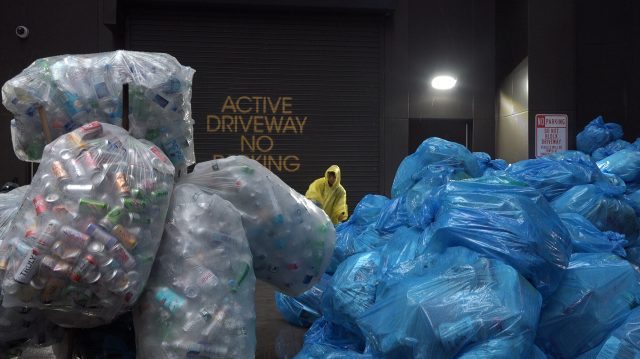WOJCIECH GILEWICZ Trash Walks
Opening: 28.01.2022, opening hour: 16.00-20.00
Open until: 11.03.2022, opening hours: TUE-SAT 12.00-18.00

Trash Walks
Trash Walks by Wojciech Gilewicz is an exhibition that explores the artist’s many years of interest in the subject of trash and its circulation. It consists of videos made in the United States, a collection of over 1,800 photographs from the city of Kaohsiung in Taiwan and a series of oil paintings on canvas Paintings 2002-. The artist also shows works specially prepared for this presentation at the Biała Gallery, with which he has been collaborating since 2000.
The exhibition covers topics related to ecology, recycling, exchange, and freecycling. Its binding motive is the issue of “trash” – that is, everything that we consider redundant and unnecessary and that we get rid of from our homes and lives. At a time when all news channels are beating the drum of the climate crisis, the exhibition in Biała Gallery examines civic responsibility and agency, spins romantic stories about “civic duty” and limiting consumption.
In addition to examples of enormous waste (which we witness and often perpetrate ourselves), of resources such as clothing, furniture, or everyday objects, as well as all kinds of materials and raw materials, or food, the film entitled Trash Walks (2021) presents alternative social attitudes to waste and trash. They are e.g., dumpster diving, which is the search for things in the trash that might still be of use. This does not always have to be the result of the economic situation, but a philosophy of life, a lifestyle, and the ideology of the maximal use of resources, the so-called no waste and circular economy. There is also freeganism, which involves reducing one’s individual contribution to the conventional economy by searching in the trash for food (for example) that is fit for consumption but discarded by stores, such as products past their expiration date; bakery products that have not been sold or excess food prepared in restaurants. All these behaviours significantly reduce consumption and have an impact, even if in a minimal way, on preserving our planet.
Recalling the saying: “One man’s trash is another man’s treasure” the exhibition also touches upon the topic of collecting or simply gathering things. At the same time, it is balancing between artistic collecting and compulsive collecting, which in its morbid manifestation is more widely known as hoarding. It is an officially recognized and increasingly frequent addiction, just like alcoholism or drug addiction.
In the case of Gilewicz, art is strongly intertwined with life, which the exhibition demonstrates by documenting the artist’s civic engagement. As a resident and citizen, he conducts endless exchanges of letters, petitions and complaints regarding problems related to waste management in the Praga Południe district in Warsaw, where he lives and works. This correspondence with authorities is accompanied by extensive photographic documentation.
For the first time, the remarkable Kaohsiung Photo Collection (2020) will be shown in its entirety. This is a collection of over 1,800 photographs found by the artist in the trash in the city of Kaohsiung in southern Taiwan. This comprehensive and linear collection of photographs dates back to the early 20th century. It is represented by gelatin-silver prints, photographs from the 1970s (with photographs with rounded corners, which are uncommon in Poland), monochromatic, faded because of the photographic chemistry that was imperfect at that time. The collection ends in 2012, which most likely marks the date of the death of the owner of this photo collection. The photographs, taken out of their original, historical, and cultural context, constitute a perfect pretext for weaving various stories, hypotheses and interpretations of the world presented in them. Part of this unique collection has been professionally restored, adding economic value to this incredible trash find.
An extraordinary collection of postcards from the 1960s, found by Gilewicz in the trash in Warsaw complements the collection of photographs from Taiwan, and forms a bridge between the three continents. The recipient of the postcards is a mysterious lady from Lublin, and on many of them, we can see views of the city from the past. This randomness fits perfectly with the exhibition’s narrative of universalism about trash, individual stories, and memory, for which the artist accidentally becomes a self-proclaimed guardian.
The theme of cleaning up, and even cleaning up the world in the films RRRC (2015), Residency Unlimited (2012) and Art Cleaning (2015), that runs through Gilewicz’s exhibition, appears to us as a simultaneously monotonously meditative, relaxing and “cleansing” activity. The act of “civic duty” (known in Poland from the communist era) is given, perhaps naively and wishfully, the elements of the salvation of the world of the Anthropocene era and ecological crisis, putting into practice the Taiwanese adage: “Instead of wondering whether the catastrophe can still be stopped, pick up a piece of trash from the road and take it with you.”
Another important project presented at the exhibition is a series of oil paintings on canvas Gilewicz has been working on for 20 years now, entitled Paintings 2002-. The artist invites the public to create them. According to a few simple guidelines, the participants paint them themselves. The series of these “reusable” paintings is covered with up to several dozen layers of paint. Currently, it includes 161 canvases. In the Biała Gallery it adds nine new ones.
During the pandemic, which forces us to re-evaluate our economic, ecological, and social behaviour, the exhibition is conceived as an open process involving viewers in their own interpretations and activities in the social, intellectual, and artistic spheres.
author: @Walewska8studio
translation: Natalia Kuta
ATTENTION!
Full regulations for the functioning of the Cultural Center in Lublin in connection with the organization of cultural events during the SARS-CoV-2 virus epidemic in Poland > https://bit.ly/regulamin_funkcjonowania_CentrumKultury













































